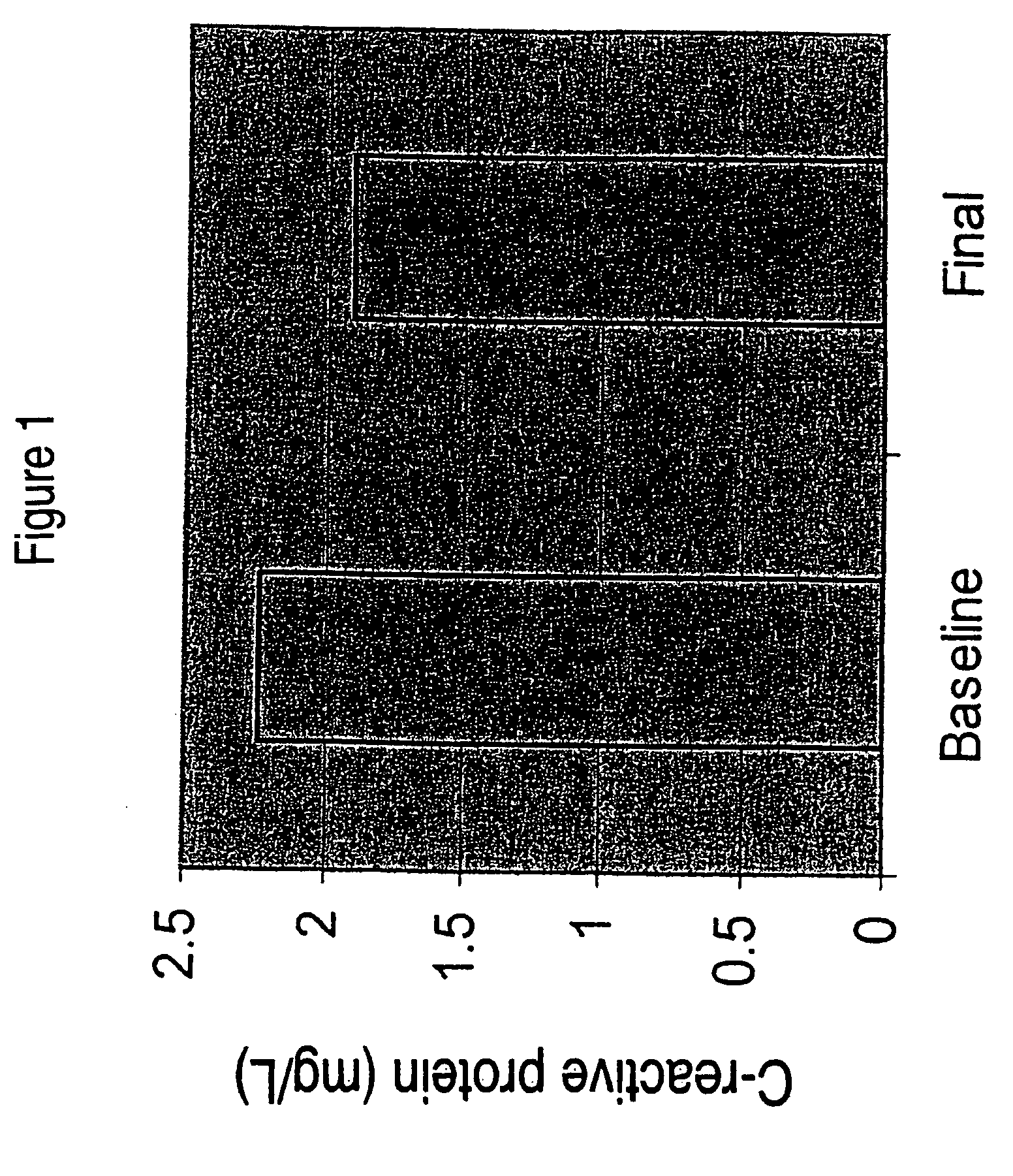Prophylactic docosahexaenoic acid therapy for patients with subclinical inflammation
a technology of docosahexaenoic acid and subclinical inflammation, which is applied in the direction of drug composition, metabolic disorder, cardiovascular disorder, etc., can solve the problems of systemic inflammation inflicting devastating degenerative effects throughout the body, embolizing, thrombosis, and approximately 150,000 deaths, so as to reduce subclinical inflammation and reduce subclinical inflammation. , the effect of reducing subclinical inflammation
- Summary
- Abstract
- Description
- Claims
- Application Information
AI Technical Summary
Benefits of technology
Problems solved by technology
Method used
Image
Examples
example 1
[0074] In a clinical study DHASCO capsules (which contained DHA as a triglyceride oil extracted from Crypthecodinium cohnii cells, obtained from Martek Biosciences Corp., Columbia, Md.) were co-administered with statin medication to patients with dyslipidemia. Hyperlipidemic patients already being treated with a stable dose of a statin medication but still failing to meet NCEP guidelines for LDL-cholesterol or triglycerides were treated with either 200 or 1000 mg of DHA daily for 12 months. HbA1c levels (glycosylated hemoglobin, a marker of glycemic control) were measured in plasma at baseline and after 8 or 12 months of treatment. The HBA1c levels were significantly reduced in the high dose group (1000 mg DHA / day) after one year of treatment compared to the low dose group (200 mg DHA per day).
[0075] In this study, thirteen of 20 patients treated with DHA showed reductions in CRP levels, for an overall reduction of 15% in CRP level. Reduction in CRP of this extent is clinically sig...
example 2
[0076] To validate the results of the clinical trial described in Example 1, a population of 300 individuals who have suffered a heart attack may be selected for study. All members of the study will be tested for C-reactive protein levels and the inflammatory markers IL-6, ICAM, VCAM, p-selectin, TNFα, LTB4 and for peripheral blood mononuclear cell immune reactivity (PBMC, e.g. white blood cells). Alternatively, at least three of the above markers may be selected for monitoring in the study. The population will then be randomly divided into two treatment groups. The first treatment group will receive DHA according to the invention in the amount of 1 g / day in capsules containing a triglyceride oil that is 50% DHA. The second treatment group will receive a placebo which will contain soybean oil or a suitable substitute in the amount of 2 g / day. Each group will maintain the treatment course for a period of at least six months to a year. Over the evaluation period inflammatory marker te...
example 3
[0077] To validate the effectiveness of the combination therapy, a clinical trial a population of 300 individuals who have suffered a heart attack may be selected for study. All members of the study will be tested for C-reactive protein levels and the inflammatory markers IL-6, ICAM, VCAM, p-selectin, TNFα, LTB4 as well as PBMC immune reactivity. Alternatively, at least three of the above markers may be selected for monitoring during the study. The population will then be randomly divided into two treatment groups. The first treatment group will receive DHA in the amount of 1 g / day and 81 mg / day of aspirin. The second treatment group will receive a placebo which will contain soybean oil or a suitable substitute in the same amount based on TFA and 81 mg / ml of aspirin. Each group will maintain the treatment course for a period of at least six months to a year. Over the evaluation period inflammatory marker testing will be performed monthly. Additionally, at least at the onset and conc...
PUM
| Property | Measurement | Unit |
|---|---|---|
| body weight | aaaaa | aaaaa |
| weight ratio | aaaaa | aaaaa |
| time | aaaaa | aaaaa |
Abstract
Description
Claims
Application Information
 Login to View More
Login to View More - R&D
- Intellectual Property
- Life Sciences
- Materials
- Tech Scout
- Unparalleled Data Quality
- Higher Quality Content
- 60% Fewer Hallucinations
Browse by: Latest US Patents, China's latest patents, Technical Efficacy Thesaurus, Application Domain, Technology Topic, Popular Technical Reports.
© 2025 PatSnap. All rights reserved.Legal|Privacy policy|Modern Slavery Act Transparency Statement|Sitemap|About US| Contact US: help@patsnap.com

